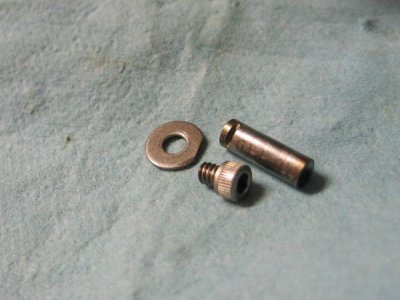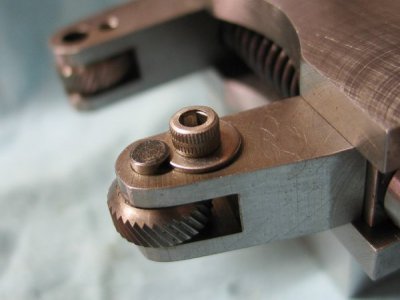-
Welcome back Guest! Did you know you can mentor other members here at H-M? If not, please check out our Relaunch of Hobby Machinist Mentoring Program!
You are using an out of date browser. It may not display this or other websites correctly.
You should upgrade or use an alternative browser.
You should upgrade or use an alternative browser.
Knurled Tool
- Thread starter oskar
- Start date
- Joined
- Dec 20, 2012
- Messages
- 9,422
That likely occurred during the migration from the old to new server. Sorry about that.
Okay, no problem, Nelson. We'll just respond again. Thanks for looking into it.
Mike
- Joined
- Dec 20, 2012
- Messages
- 9,422
Thanks Mike for your time and definitely it’s a project I would like to do. I found the FormRol site which is very good with tons of information plus I found a .PDF document about Knurls which I will read to educate myself.
No need for plans but I have these questions:
What is the approx. overall size of the main block?
What is the size of the main bolt? Are the threads coarse or fine?
What is the size of the knurls you have?
Much appreciated
Nicolas
I'm gonna' try to remember what I said the first time but if I miss something, ask, okay?
The mounting block is 6061-T6; 2-1/4" front to back, 1-1/2" high, 1-1/4" thick. The mounting block places the centerline of the knurler on the centerline of the lathe behind the work piece. The bottom of the knurler plate registers on the edge of the cross slide and when the screws are locked down into the T-nuts in the cross slide, the entire knurling tool is solidly held and cannot turn or move unless you want it to. Some users feel that a slight angle of the knurls toward the headstock is desirable; I have not found this to be necessary.
Contrast this to the Sherline tool, which is intended to be mounted loose so the base of the tool can move. Presumably, this is to allow the knurls to track better. My results suggest that a solidly mounted knurler with tight tolerances will form a more precise knurl with very little chance of mistracking if everything is done right.
The main tension screw is 12L14. The threads were 1/4-28 on top with a class 3 fit into the top nut. The bottom thread inserts into the half-moon insert with a 1/4-20 thread, Loc-tited in. 12L14 is more than adequate for this application because there is not an excessive amount of tension on the stud. Over the years, it has performed flawlessly with no sign of wear.
Knurls are from FormRol, 1/2" OD X 1/4" thick X 3/16" ID hole. These knurls are from the EQ series (1/4" wide) instead of the EP series (3/16" wide EPR/EPL 230) that Sherline uses. The knurls I used were the straight EQ 230 pair (fine pitch to reduce mistracking), EQR/EQL 225 and EQR/EQL 230. I had them custom grind a bevel on both sides to allow for axial running and they work well for that.
All knurls above are Circular Pitch knurls. I do not use Diametric Pitch knurls and do not calculate diameters; I just crank down to achieve about a 90% pattern depth and run the knurl. Note that FormRol considers anything deeper than a 90% pattern to be over-knurling that can damage your knurls. These are HSS knurls but I've done a fair number of knurls in stainless steel and have noted no significant wear. If I were to do a lot of it in SS though, I would use cobalt knurls and maybe switch to carbide pins.
Unasked for info:
- Side plates are 1/4" thick mild steel.
- Arms are 5/8" mild steel, milled square to 1/2" X 1/2" X 3" long.
- Top nut is 12L14 steel.
- Delrin washer underneath top nut
- Half-moon inserts are 1/2" OD, O-1 tool steel left in annealed state. No point in hardening them when they run in mild steel with very little movement.
- Aluminum spacers are ~3/8" OD.
- Joined
- Dec 20, 2012
- Messages
- 9,422
@Ken from ontario wrote:
Mikey, I got a question for you, the pins that hold the knurls, how are they secured so they don't become loose and slide off? I'm working on modifying a bump type knurling tool and for the pins I used SH cap screws with lock nuts ,I like your approach better, it looks cleaner , I have lots of drill rod to use but as I said I'm worried in case the knurls would slide off during the operation unless they are slip fit.
Oskar, I'm sorry for posting this question in your thread but it is something you may encounter yourself if you decide to build the tool from scratch.
Then Dave (@British Steel) nailed it:
Hi Ken,
I may be wrong (Mikey won't be!) but the 2 SHCS visible on the scissor arms look like they have washers under their heads, and those could fit in a groove in the pins, locking them in place?
Dave H. (the other one)
I will respond again for the benefit of those who come later and expect an answer.
The pins are 3/16" drill blanks, not drill rod. They have a shallow slot cut on one end. A stainless washer has a flat ground on one side that fits into this slot. A 6-32 SCHC locks the washer in place. This holds the pin solidly but allows for very quick disassembly for cleaning. I got this idea from one of Guy Lautard's bedside readers and it works well. Drill blanks are hardened and the slots were cut with a Dremel abrasive wheel.


Mikey, I got a question for you, the pins that hold the knurls, how are they secured so they don't become loose and slide off? I'm working on modifying a bump type knurling tool and for the pins I used SH cap screws with lock nuts ,I like your approach better, it looks cleaner , I have lots of drill rod to use but as I said I'm worried in case the knurls would slide off during the operation unless they are slip fit.
Oskar, I'm sorry for posting this question in your thread but it is something you may encounter yourself if you decide to build the tool from scratch.
Then Dave (@British Steel) nailed it:
Hi Ken,
I may be wrong (Mikey won't be!) but the 2 SHCS visible on the scissor arms look like they have washers under their heads, and those could fit in a groove in the pins, locking them in place?
Dave H. (the other one)
I will respond again for the benefit of those who come later and expect an answer.
The pins are 3/16" drill blanks, not drill rod. They have a shallow slot cut on one end. A stainless washer has a flat ground on one side that fits into this slot. A 6-32 SCHC locks the washer in place. This holds the pin solidly but allows for very quick disassembly for cleaning. I got this idea from one of Guy Lautard's bedside readers and it works well. Drill blanks are hardened and the slots were cut with a Dremel abrasive wheel.


- Joined
- Nov 24, 2013
- Messages
- 268
Thanks Mike for your time and the detailed description. BTW your knurled tool looks more like a piece of art than a tool, its amazing!
I will never achieve such a workmanship with my limited skills however I will try to make a workable tool.
Nicolas
I will never achieve such a workmanship with my limited skills however I will try to make a workable tool.
Nicolas
- Joined
- Dec 20, 2012
- Messages
- 9,422
Thanks Mike for your time and the detailed description. BTW your knurled tool looks more like a piece of art than a tool, its amazing!
I will never achieve such a workmanship with my limited skills however I will try to make a workable tool.
Nicolas
Thanks, Nicolas, but its just a tool, done with care. You CAN do this. If you like, PM me and we can work on it together.
- Joined
- Nov 24, 2013
- Messages
- 268
Thanks, Nicolas, but its just a tool, done with care. You CAN do this. If you like, PM me and we can work on it together.
Much appreciated Mike, finishing now a QCTP and when this is done I will start the knurl tool. Have to order some material and I will contact you when needed.
BTW trying to order the the drill blanks from KBC tools but they dont show the length and when I called the guy said its "Jobbers length" but did not know the actual length. Anyone knows what length is "jobbers length"?
Since I'm in Canada I try to order locally and the knurls available are as per attached picture. I choose the 25TPI/50T. Is this acceptable or another choice will be better? I only work with aluminum
http://www.kbctools.ca/customer/kbtoin/customerpages/digitalcatalogs/cmaster.htm#book/281
Nicolas
